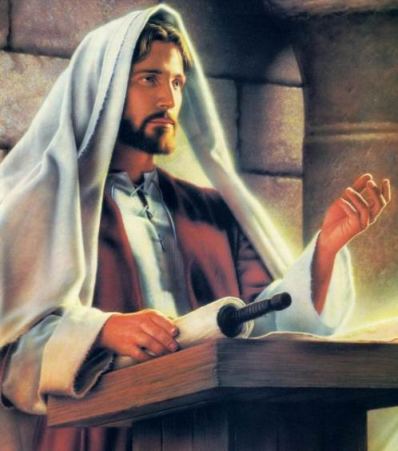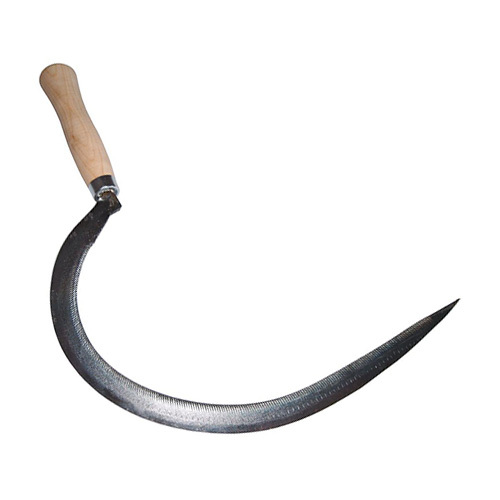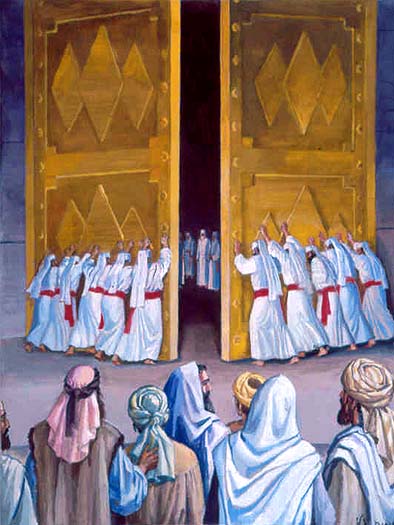"A New Approach to Revelation" by Tricia Tillin (Part 14)
how the day of atonement Temple service sheds light on the book of revelation - Back to the Beginning
We have arrived at the final stage of the Yom Kippur ceremonies. The atonement sacrifices have been dispatched, and sin is removed! Now all that remains is to conduct the normal evening service before going home. The joy of Tabernacles is approaching for the faithful, but before that, terrible punishment is to befall satan and his followers.
The final part of Yom Kippur itself [before evening worship] is the reading of the Torah. The High Priest changes his garments, takes off his linen robes, and puts on the usual golden vestment. He then proceeds to the Women's Court where the people wait to worship and respond to his blessings. He is handed a scroll and begins to read.
![]() Go Back to Summary/Contents Page
Go Back to Summary/Contents Page
Another Sinai Moment
There is one significant thing to note. It is that the High Priest "stands up", so we are to imagine that he has previously been seated, we known not how nor where. Jesus did the same in the Synagogue:
Luke 4:16: So He came to Nazareth, where He had been brought up. And as His custom was, He went into the synagogue on the Sabbath day, and stood up to read. And He was handed the book of the prophet Isaiah. And when He had opened the book, He found the place where it was written... Then He closed the book, and gave it back to the attendant and sat down.
 Jesus stood up to read, then sat down to teach. This might appear to be a minor point, but it is important enough to be mentioned in rabbinical literature. Why did the High Priest stand to read? The Jews also were puzzled by this ruling. We as Christians would perhaps remember the biblical meaning of "standing up". We know that it means God is about to DO something, as opposed to being seated in repose.
Jesus stood up to read, then sat down to teach. This might appear to be a minor point, but it is important enough to be mentioned in rabbinical literature. Why did the High Priest stand to read? The Jews also were puzzled by this ruling. We as Christians would perhaps remember the biblical meaning of "standing up". We know that it means God is about to DO something, as opposed to being seated in repose.
Jesus our High Priest is SEATED at the right hand of God, having completed his work of salvation. However, when he STANDS, it means that His latter-day work as Coming King and Judge is about to commence.
Also, it means that God is about to SPEAK to mankind! Just as He descended to the Mount and spoke with Moses, giving him the Law, so at the end of time Jesus will descend to the Mount, to give mankind God's Rule.
Zechariah 14:4-5 And in that day His feet will stand on the Mount of Olives, which faces Jerusalem on the east. And the Mount of Olives shall be split in two, from east to west, making a very large valley; half of the mountain shall move toward the north and half of it toward the south. Then you shall flee through My mountain valley, for the mountain valley shall reach to Azal. Yes, you shall flee as you fled from the earthquake In the days of Uzziah king of Judah. Thus the Lord my God will come, and all the holy ones with Him.
High Priest Reads from the Torah
In the Temple at Yom Kippur, the High Priest goes through to the Women's Court and is handed a scroll. In reality this was the Torah, but in Revelation will Jesus read the now-unsealed scroll containing the Atonement Decree? Is this scroll about release of the captives, the return of the land, and the judgement of wickedness? We are not told. We can only surmise. But it is certain that he STOOD to read:
We noted that the High Priest stood to read the Torah, the king who did so was praised by the rabbis, and when Jesus read in the synagogue, he too stood. While this might seem simply a logistical ideal enabling the reader to project his voice and receive the congregation's attention, the rabbinic discussions would suggest otherwise..... Standing to read the Torah is much more than a logistical necessity or an expression of respect. According to this interpretation, by standing, the reader emulates, not Moses who stood to receive the Torah, but God who revealed it. The ritual reading of the Torah then, is not simply an act of study, but a reenactment of Sinai itself. The tradition recorded in the Palestinian Talmud does not go quite this far, but it does rebuke the reader who leans against the table while reading, saying that this is forbidden because "just as [the Torah] was given with fear and reverence, so too we need to treat it with fear and reverence." …the public reading is … a reenactment of Sinai and is to be treated as such. ["Study of Scripture to a Re-enactment of Sinai" Ruth Langer, Theology Department, Boston College]
Just as in the Temple, the people gather to worship and respond to the word of God. In Revelation 14 we see the one-hundred and forty-four thousand sealed of God raising their voices in a song of worship, accompanied by musicians.
Wine and Grain
With the reading of the Torah finished, the High Priest can continue the evening service.
 After a few more sin-offerings [two rams and seven sheep] the offerings of WINE and GRAIN are again given on the main altar. At this same point in Revelation we see the HARVEST of the GRAIN and the GRAPE. (Rev 14)
After a few more sin-offerings [two rams and seven sheep] the offerings of WINE and GRAIN are again given on the main altar. At this same point in Revelation we see the HARVEST of the GRAIN and the GRAPE. (Rev 14)
We are told that the "clusters of the vine of the earth are fully ready" and the wine of Babylon's blood is about to be shed, reaching "up to the horse's bridles, for one thousand six hundred furlongs." (Rev 14:20). Such is the fate of Babylon and also - says the angel - those who worship the beast and receive his mark for "he himself shall also drink of the WINE of the wrath of God, which is POURED OUT full strength..." Rev 14:10)
Final Three Trumpets
As we learned from the morning service, the pouring out of the wine libation was the signal for the TRUMPETS to blow. Four trumpets have already blown, during the morning service, leaving just three to complete the wrath of God accompanied by the outpourings of these wine bowls. Comparing the events of the final three trumpets and the bowls we do see that they are nearly identical and together spell the complete doom of satan's kingdom.
After the first set of four trumpets, the final three are described as "woes" = "WOE, WOE, WOE to the inhabitants of earth because of the remaining blasts of the trumpet of the three angels who are about to sound!" (Rev 8:13). As I have suggested on Page Three, the three-fold sound of WOE, a moan of human lament, is near identical to the trumpet sound in the Temple. You can listen to the different sounds of the shofar on that page.
We need to remember that the TRUMPETS and BOWLS are simultaneous in the Temple worship. Here again in the evening service the last two trumpets [we shall consider the final trumpet shortly] are about the final great WAR (Armageddon) and the fall of Babylon, and at the same time the escalation of world events like the toxic water, scorching sun, pains and sores, darkness and blasphemy - begun in the "morning trumpets" - comes to a head.
Both Trumpet Six and Bowl Six deal with the river Euphrates, making a way for war to begin. Both the seventh trumpet and bowl bring about the END of satan's reign and mankind's rebellion.
Again, as in the morning the blowing of the trumpets is the signal for the people to lift up their voices in praise to God. In Revelation 15 we find the saved of God (whether earlier or by means of the sickle harvest) in worship (Rev 15).
The Temple Opened
It is time for the evening incense, normally about the "ninth hour" which equates to our 3pm but because of all the necessary activities of Yom Kippur it will now be much later, nearly dusk. So once more the "Temple in heaven" is opened. (Rev 15:5). The High Priest during the evening service offers incense, this time on the Golden Altar before the Throne. Then:
"The Temple was filled with smoke from the glory of God and from his power, and no one was able to enter the Temple till the seven plagues of the seven angels were completed" (Rev 15:8)
These final prayers rising up to God, symbolised by the incense in the Temple, result in a finality of judgement on the earth. As a result, one of the four living creatures (perhaps taking the place of Overseer of the Priests) hands the seven bowls of plagues to the seven angels who stand ready to pour. When they do, it is the final act of The DAY.
Vial or Bowl?
It is astonishing that John uses in Revelation the very word (vial or bowl) that describes the shallow vessel used in the Temple for making a wine libation! It could not be more striking that John intended us to see the angels as priests at the altar.
The Greek work translated VIAL is taken directly from the Greek PHILE and in the secular Greek dictionary is described as "a flat shallow cup or bowl, especially a drinking-bowl, for libations", Latin = Patera. Also, a funeral URN or VASE, from its broad flat shape. The "Bowl of Mars" was a comic metaphor for his SHIELD.

- Patera [Roman] or Philae [Greek] about 500BC
- Apollo pouring a libation from a philae onto the Omphalos, with his sister Artemis attending
- Roman bronze statuette of a priest, extending a patera in a gesture of libation.
- Ancient philae libation bowl on display at the Metropolitan Museum, inset with 4th Century BC Greek Bronze Philae
- Temple Institute modern Temple vessels: wine flask and libation cup
The Final Trumpet
The 'Great Trump' ended the Feast and the service. It meant the doors were shut, and nobody could thereafter obtain atonement. It is on Yom Kippur when the Great Trumpet, known in Hebrew as the Shofar HaGadol is blown. It is the Jewish belief that the gates of Heaven are open during the days of repentance to receive prayers for forgiveness and that they close after the Neilah service. When the final blast of the shofar is heard, they believe that those who have observed the day with sincerity have been inscribed and sealed in the Book of Life. Those who have not are excluded from atonement.
Neilah is the closing or final service of Yom Kippur. The Neilah Prayer on Yom Kippur is the fifth and final prayer of Yom Kippur. It means "the locking". On an ordinary day Jews prayed three times – evening, morning and afternoon. On Shabbat, holidays, and Rosh Chodesh they added an additional fourth prayer, musaf. Only on Yom Kippur are there five periods of prayer.
In Revelation we also have five distinct times of corporate praise:
- Chapter 5 - the worship of heaven and all creation because the Lamb is found worthy
- Chapter 7 - the worship of the great multitude around the throne
- Chapter 14 - the new song of the 144,000 on Mount Zion
- Chapter 15 - the song of Moses and the Lamb from the victors
- Chapter 19 - all heaven and the multitudes praise God
These are five times of public worship. I have not counted praise by the angels themselves, nor the four living creatures and 24 elders. I am sure that if I looked at the separate instances of praise and worship in Revelation, from both people and angels, then compared them to the service in the Temple, I would find them very similar if not identical. However, I do not have the time or energy to do that!
But what we do need to know is that this is the FINAL trump, announcing the coming of Jesus Christ, and ending the time of probation. Thereafter, the saved are at home with the Lord, and the unsaved are trapped outside, where there will be "weeping and wailing and gnashing of teeth". This phrase appears SEVEN times in the New Testament. Each time it indicates the condition of earth and fallen mankind at the time of Jesus' coming. For example Matthew 8:12 , Matthew 22:13 , Matthew 24:5, Luke 13:28 "There will be weeping and gnashing of teeth, when you see Abraham, Isaac, Jacob, and all the prophets, in the Kingdom of God, and yourselves being thrown outside."
The door is firmly shut against hypocrites and unrepentant sinners. They will have been caught unawares, just like those at the time of Noah and Lot:
Genesis 7:16 Those that entered, male and female of all flesh, entered as God had commanded him; and the LORD closed it [the Ark] behind him.
Genesis 19:10 But the men reached out their hands and brought Lot into the house with them, and shut the door.
Luke 13:25 "Once the head of the house gets up and shuts the door, and you begin to stand outside and knock on the door, saying, `Lord, open up to us!' then He will answer and say to you, `I do not know where you are from.'
The Neilah service was especially solemn because it was regarded as the LAST opportunity for forgiveness and reconciliation.
"While the gates are being shut, the people, exhausted by fasting and praying all day long, make another supreme effort to penetrate the gate of mercy and obtain the favor of gracious Providence." Source: Julius H Greenstone ' Jewish Feasts and Fasts' (1946) p 47
The awareness that the fate of each individual is being sealed at the end of the day is reflected in the change of wording during the Neilah prayers. "The prayers often repeated during the ten days of penitence, in which the worshipper asks to be inscribed in the book of life, are changed during Neilah for the prayer to be sealed in the book of life." Ibid P. 87
The service ends with a crescendo. When the sun begins to set, the congregation rises and cries out:Shema Yisrael! Hear, O Israel! Then it renews the pledge of loyalty to God, and calls for the establishment of His kingdom. A long, resounding blast of the shofar signal the end of the Day of Atonement. Since we are nearing the conclusion of the book of Revelation, we can say for certainty that God's KINGDOM has indeed arrived.
Time To Go Home
All that remains for both the Yom Kippur festival and the Last Day is the homecoming procession, so we will continue to the last page to see a fascinating account of that.
If you are interested, intrigued, confused, or just want to give me some feedback, please e-mail me direct: Contact Page
© 2014 Tricia Tillin-Booth. All rights reserved. Birthpangs Website: http://www.birthpangs.org/ This document is the property of its author and is not to be displayed on other websites, redistributed, sold, reprinted, or reproduced in printed in any other format without permission. Websites may link to this article, if they provide proper title and author information. One copy may be downloaded, stored and/or printed for personal research. All spelling and phraseology is UK English.
